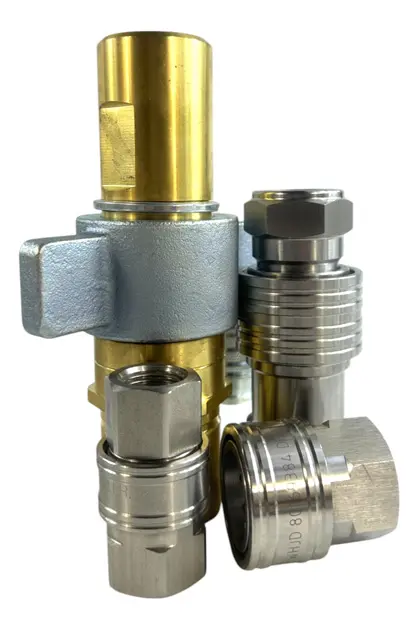Hydraulic fittings can sometimes feel like they speak their own language! You see terms like “SAE ORB,” “Dash -8,” and “UNF thread,” and it can get confusing quickly. Especially when you’re trying to figure out what size fitting you actually need.
Let’s demystify one of the most common types: SAE Straight Thread O-Ring Boss (ORB) fittings. These are popular because they create a very reliable, leak-resistant seal.
What is an SAE ORB Fitting?
SAE ORB fittings (defined by standards like SAE J1926 and ISO 11926) are a type of hydraulic connector that uses straight threads and, crucially, an O-ring to create the seal.
Unlike tapered pipe threads (like NPT) that seal by wedging the threads together, ORB fittings seal when the O-ring on the male fitting is compressed against a flat surface (the “boss“) on the female port or fitting. The straight threads hold the connection together securely, preventing loosening due to vibration.
How SAE ORB Fittings Are Sized: The Dash Number System
SAE ORB fittings are typically referenced using a “dash” number, preceded by a hyphen (e.g., -4, -8, -16). This dash number represents the nominal size of the fitting or port in sixteenths of an inch.
- A -4 size means 4/16ths of an inch, which simplifies to 1/4 inch.
- A -8 size means 8/16ths of an inch, which simplifies to 1/2 inch.
- A -16 size means 16/16ths of an inch, which simplifies to 1 inch.
This “inch” measurement (1/4″, 1/2″, 1″) is the nominal size – it gives you an idea of the flow capacity or port size, but it’s not the actual size of the thread.
The Link: Dash Size to UNF Thread
The actual threads used on SAE ORB fittings are UNF (Unified Fine) threads. Each dash size corresponds to a specific, precise UNF thread size (diameter and threads per inch).
Here’s a table showing the relationship between common SAE ORB dash sizes and their corresponding UNF thread sizes:
| Dash Size | Nominal Size (in sixteenths) | Corresponding Nominal Size (in inches) | Actual Thread Size (UNF) |
|---|---|---|---|
| -4 | 4/16″ | 1/4″ | 7/16″-20 UNF |
| -6 | 6/16″ | 3/8″ | 9/16″-18 UNF |
| -8 | 8/16″ | 1/2″ | 3/4″-16 UNF |
| -10 | 10/16″ | 5/8″ | 7/8″-14 UNF |
| -12 | 12/16″ | 3/4″ | 1-1/16″-12 UNF |
| -16 | 16/16″ | 1″ | 1-1/4″-12 UNF |
| -20 | 20/16″ | 1-1/4″ | 1-5/8″-12 UNF |
| -24 | 24/16″ | 1-1/2″ | 1-7/8″-12 UNF |
| -32 | 32/16″ | 2″ | 2-1/2″-12 UN (or UNF) |
So, when you see a “-16 SAE ORB” fitting, you know it’s a 1″ nominal size, and it will have a 1-1/4″-12 UNF thread.
Male vs. Female Threads: Are They Different Sizes?
A point of confusion sometimes arises: are the male and female ORB threads different sizes? No, for them to connect, the threads must be the exact same size and pitch!
- A male fitting with a 1-1/4″-12 UNF thread is designed to screw into a female port or fitting with a 1-1/4″-12 UNF thread.
The difference between the male and female ORB is not the thread size, but:
- The presence of the O-ring: The male fitting has the groove and the O-ring.
- The sealing surface: The female port has the flat “boss” surface that the O-ring compresses against.
They are designed to mate perfectly because their threads match, and the O-ring provides the seal when they are tightened.
Standards Ensure Interchangeability
SAE J1926 and ISO 11296 are the standards that define the exact dimensions for these ports and fittings. This standardization is why you can typically mix and match compliant male fittings and female ports from different manufacturers – they are all built to the same specifications.
Identifying Your Fitting
If you’re unsure about the size of an existing SAE ORB fitting:
- Check for Markings: Sometimes sizes are stamped on the fitting itself.
- Measure the Threads: Use a caliper to measure the outside diameter of the male thread (or the inside diameter of the female thread) and a thread gauge to count the threads per inch (TPI). Compare your measurements to a standard ORB thread chart.
- Determine Dash Size: Once you know the actual thread size, you can look it up on a chart (like the one above) to find the corresponding dash size and nominal size.
Putting It All Together
SAE ORB fittings use a simple yet effective system:
- A dash number tells you the nominal size (in sixteenths of an inch).
- Each dash number corresponds to a specific UNF thread size.
- Male and female fittings intended to connect have the same thread size.
- The O-ring on the male seals against the flat boss on the female port.
Understanding this relationship makes working with SAE ORB fittings much easier and helps ensure you order the correct parts for a leak-free hydraulic system.
Still have questions? Don’t hesitate to contact us or bring your fitting in! We’re here to help you identify exactly what you need.
